Multi-Scenario Simulation of Urban Growth under Integrated Urban Spatial Planning: A Case Study of Wuhan, China
Abstract
1. Introduction
2. Study Area and Datasets
2.1. Study Area
2.2. Datasets
- Land-use maps of 2009 and 2017 in vector format were obtained from Wuhan Natural Resources and Planning Information Center. The original land-use maps were categorized into 38 classes and, then, reclassified into nine land-use types: urban land, rural settlements, cropland, orchard land, forests, grassland, waterbodies, traffic land and other land.
- Socioeconomic datasets were collected from various sources. The demographic and GDP data of 2015 were downloaded from the Resource and Environment Data Cloud Platform website http://www.data.ac.cn (accessed on 20 October 2018). POI data were obtained from Baidu Map website http://map.baidu.com (accessed on 20 December 2017). The vector road network and park data were derived from Wuhan Geographical Conditions Monitoring Datasets, which are produced by Wuhan Geomatics Institute in 2017. Other socioeconomic datasets, including land value, urban centers, commercial centers and subway stations, were downloaded in picture format from the Wuhan Natural Resources and Planning Bureau website http://zrzyhgh.wuhan.gov.cn/ (accessed on 6 January 2019) and, then, digitized in ArcGIS 10.2 software. These socioeconomic datasets were mainly used to process the driving factors of the urban CA model.
- Natural eco-environment datasets include topographical, meteorological, soil, vegetation and farmland quality data. The topographical information was derived from a digital elevation model (DEM) in raster format with a resolution of 30 m × 30 m, supplied by Geospatial Data Cloud website http://www.giscloud.cn/ (accessed on 30 January 2017). Meteorological data for 2015 obtained from China Meteorological Data Sharing Service System website http://data.cma.cn/site/index.html (accessed on 9 March 2016) include monthly air temperature, monthly rainfall and monthly radiation. Soil data, such as soil type, soil particle proportion and soil organic matter, were extracted from the Harmonized World Soil Database version 1.2 website http://westdc.westgis.ac.cn (accessed on 30 August 2019). Vegetation data, incorporating normalized difference vegetation index (NDVI) and leaf area index (LEI), were obtained from MODIS products. Farmland quality data were derived from the grade evaluation result of cultivated land quality in 2015, produced by Wuhan Natural Resources and Planning Information Center. These natural eco-environment datasets were mainly utilized to evaluate the cell-based conservation priority.
- Planning datasets, consisting of the Wuhan City Master Plan (2010–2020), Wuhan Land Use Master Plan (2006–2020) and its adjustment and improvement result (2017), Wuhan Basic Farmland Protection Plan (2006–2020), Wuhan Comprehensive Transportation Plan (2009–2020) and Wuhan Ecological Protection Plan (2012), were acquired from Wuhan Natural Resources and Planning Bureau website http://zrzyhgh.wuhan.gov.cn/ (accessed on 30 January 2019). These planning datasets were integrated to produce urban growth scenarios based on dynamic planning constraints.
3. Methodology
3.1. Cell-Based Conservation Priority and Urban Growth Potential
3.1.1. Conservation Priority Evaluation
3.1.2. Urban Growth Potential Evaluation
3.2. Planning-Constrained Mechanism
3.3. Planning-Constrained CA Model
3.4. Multi-Scenario Design of Planning Constraints on Urban Growth
4. Model Application and Results
4.1. Urban Growth and Encroachment in 2009–2017
4.2. Calibration and Validation of the Simulation Model
4.3. Multi-Scenario Simulation of Urban Growth Based on Planning Constraints
5. Discussion
6. Conclusions
- The planning-constrained CA model demonstrated a higher simulation accuracy compared to the model without planning constraints.
- The simulation result of 2017 shows that a weak planning-constrained urban development was consistent with the actual situation.
- With the weakening of planning constraints, urban growth tends to occupy more ecological and agricultural land with high conservation priority. With the increase in preference on urban growth or ecological land and cultivated land protection in the EAZ, the future urban land pattern becomes more fragmented.
- Location and quantity of new urban land beyond the planned urban development area can be captured in future urban scenarios, which will provide certain early warning.
Author Contributions
Funding
Institutional Review Board Statement
Informed Consent Statement
Data Availability Statement
Conflicts of Interest
References
- Bai, X.; Shi, P.; Liu, Y. Society: Realizing China’s urban dream. Nature 2014, 509, 158–160. [Google Scholar] [CrossRef]
- Mcphearson, T. Scientists must have a say in the future of cities. Nature 2016, 538, 165–166. [Google Scholar] [CrossRef]
- Zhou, L.; Dang, X.; Sun, Q.; Wang, S. Multi-scenario simulation of urban land change in Shanghai by random forest and CA-Markov model. Sustain. Cities Soc. 2020, 55, 102045. [Google Scholar] [CrossRef]
- Seto, K.C.; Güneralp, B.; Hutyra, L.R. Global forecasts of urban expansion to 2030 and direct impacts on biodiversity and carbon pools. Proc. Natl. Acad. Sci. USA 2012, 109, 16083–16088. [Google Scholar] [CrossRef]
- Grimm, N.B.; Faeth, S.H.; Golubiewski, N.E.; Redman, C.L.; Wu, J.; Bai, X.; Briggs, J.M. Global Change and the Ecology of Cities. Science 2008, 319, 756–760. [Google Scholar] [CrossRef]
- Grêt-Regamey, A.; Altwegg, J.; Sirén, E.A.; van Strien, M.J.; Weibel, B. Integrating ecosystem services into spatial planning—A spatial decision support tool. Landsc. Urban Plan. 2017, 165, 206–219. [Google Scholar] [CrossRef]
- Li, Y.; Ma, Q.; Song, Y.; Han, H. Bringing conservation priorities into urban growth simulation: An integrated model and applied case study of Hangzhou, China. Resour. Conserv. Recycl. 2019, 140, 324–337. [Google Scholar] [CrossRef]
- McCormick, K.; Anderberg, S.; Coenen, L.; Neij, L. Advancing sustainable urban transformation. J. Clean. Prod. 2013, 50, 1–11. [Google Scholar] [CrossRef]
- Godwin, C.; Chen, G.; Singh, K.K. The impact of urban residential development patterns on forest carbon density: An integration of LiDAR, aerial photography and field mensuration. Landsc. Urban Plan. 2015, 136, 97–109. [Google Scholar] [CrossRef]
- Haberl, H. Competition for land: A sociometabolic perspective. Ecol. Econ. 2015, 119, 424–431. [Google Scholar] [CrossRef]
- Ke, X.; van Vliet, J.; Zhou, T.; Verburg, P.H.; Zheng, W.; Liu, X. Direct and indirect loss of natural habitat due to built-up area expansion: A model-based analysis for the city of Wuhan, China. Land Use Policy 2018, 74, 231–239. [Google Scholar] [CrossRef]
- He, J.; Liu, Y.; Yu, Y.; Tang, W.; Xiang, W.; Liu, D. A counterfactual scenario simulation approach for assessing the impact of farmland preservation policies on urban sprawl and food security in a major grain-producing area of China. Appl. Geogr. 2013, 37, 127–138. [Google Scholar] [CrossRef]
- Zhang, Y.; Liu, Y.; Zhang, Y.; Kong, X.; Jing, Y.; Cai, E.; Zhang, L.; Liu, Y.; Wang, Z.; Liu, Y. Spatial Patterns and Driving Forces of Conflicts among the Three Land Management Red Lines in China: A Case Study of the Wuhan Urban Development Area. Sustainability 2019, 11, 2025. [Google Scholar] [CrossRef]
- Long, Y.; Han, H.; Tu, Y.; Shu, X. Evaluating the effectiveness of urban growth boundaries using human mobility and activity records. Cities 2015, 46, 76–84. [Google Scholar] [CrossRef]
- Tong, X.; Feng, Y. How current and future urban patterns respond to urban planning? An integrated cellular automata modeling approach. Cities 2019, 92, 247–260. [Google Scholar] [CrossRef]
- Li, X.; Lao, C.; Liu, Y.; Liu, X.; Chen, Y.; Li, S.; Ai, B.; He, Z. Early warning of illegal development for protected areas by integrating cellular automata with neural networks. J. Environ. Manag. 2013, 130, 106–116. [Google Scholar] [CrossRef]
- Tobler, W.R. Cellular Geography. In Philosophy in Geography; Gale, S., Olsson, G., Eds.; Springer: Dordrecht, The Netherlands, 1979; pp. 379–386. [Google Scholar] [CrossRef]
- Liu, Y.; Batty, M.; Wang, S.; Corcoran, J. Modelling urban change with cellular automata: Contemporary issues and future research directions. Prog. Hum. Geogr. 2021, 45, 3–24. [Google Scholar] [CrossRef]
- Berberoğlu, S.; Akın, A.; Clarke, K.C. Cellular automata modeling approaches to forecast urban growth for Adana, Turkey: A comparative approach. Landsc. Urban Plan. 2016, 153, 11–27. [Google Scholar] [CrossRef]
- Liang, X.; Liu, X.; Li, D.; Zhao, H.; Chen, G. Urban growth simulation by incorporating planning policies into a CA-based future land-use simulation model. Int. J. Geogr. Inf. Sci. 2018, 32, 2294–2316. [Google Scholar] [CrossRef]
- Zhang, Q.; Su, S. Determinants of urban expansion and their relative importance: A comparative analysis of 30 major metropolitans in China. Habitat Int. 2016, 58, 89–107. [Google Scholar] [CrossRef]
- Li, J.; Deng, X.; Seto, K.C. Multi-level modeling of urban expansion and cultivated land conversion for urban hotspot counties in China. Landsc Urban Plan. 2012, 108, 131–139. [Google Scholar] [CrossRef]
- Tian, G.; Ma, B.; Xu, X.; Liu, X.; Xu, L.; Liu, X.; Xiao, L.; Kong, L. Simulation of urban expansion and encroachment using cellular automata and multi-agent system model—A case study of Tianjin metropolitan region, China. Ecol. Indic. 2016, 70, 439–450. [Google Scholar] [CrossRef]
- Lagarias, A. Urban sprawl simulation linking macro-scale processes to micro-dynamics through cellular automata, an application in Thessaloniki, Greece. Appl. Geogr. 2012, 34, 146–160. [Google Scholar] [CrossRef]
- Liao, J.; Tang, L.; Shao, G.; Su, X.; Chen, D.; Xu, T. Incorporation of extended neighborhood mechanisms and its impact on urban land-use cellular automata simulations. Environ. Model. Softw. 2016, 75, 163–175. [Google Scholar] [CrossRef]
- Onsted, J.A.; Chowdhury, R.R. Does zoning matter? A comparative analysis of landscape change in Redland, Florida using cellular automata. Landsc Urban Plan. 2014, 121, 1–18. [Google Scholar] [CrossRef]
- Yin, H.; Kong, F.; Yang, X.; James, P.; Dronova, I. Exploring zoning scenario impacts upon urban growth simulations using a dynamic spatial model. Cities 2018, 81, 214–229. [Google Scholar] [CrossRef]
- Li, L.; Song, Y.; Wei, X.; Dong, J. Exploring the impacts of urban growth on carbon storage under integrated spatial regulation: A case study of Wuhan, China. Ecol. Indic. 2020, 111, 106064. [Google Scholar] [CrossRef]
- Xi, F.; He, H.S.; Hu, Y.; Bu, R.; Chang, Y.; Wu, X.; Liu, M.; Shi, T. Simulating the impacts of ecological protection policies on urban land use sustainability in Shenyang-Fushun, China. Int. J Urban Sustain. Dev. 2010, 1, 111–127. [Google Scholar] [CrossRef]
- Wang, W.; Jiao, L.; Jia, Q.; Liu, J.; Mao, W.; Xu, Z.; Li, W. Land use optimization modelling with ecological priority perspective for large-scale spatial planning. Sustain. Cities Soc. 2021, 65, 102575. [Google Scholar] [CrossRef]
- Wang, H.; Xia, C.; Zhang, A.; Deng, Y. Scenario simulation and control of metropolitan outskirts urban growth based on constrained CA: A case study of Jiangxia District of Wuhan City. Prog. Geogr. 2016, 35, 793–805. [Google Scholar] [CrossRef][Green Version]
- Yeh, A.G.O.; Li, X.; Xia, C. Cellular Automata Modeling for Urban and Regional Planning. In Urban Informatics; Shi, W., Goodchild, M.F., Batty, M., Kwan, M.-P., Zhang, A., Eds.; Springer: Singapore, 2021; pp. 865–883. [Google Scholar] [CrossRef]
- Hersperger, A.M.; Grădinaru, S.; Oliveira, E.; Pagliarin, S.; Palka, G. Understanding strategic spatial planning to effectively guide development of urban regions. Cities 2019, 94, 96–105. [Google Scholar] [CrossRef]
- Dadashpoor, H.; Azizi, P.; Moghadasi, M. Analyzing spatial patterns, driving forces and predicting future growth scenarios for supporting sustainable urban growth: Evidence from Tabriz metropolitan area, Iran. Sustain. Cities Soc. 2019, 47, 101502. [Google Scholar] [CrossRef]
- Shoemaker, D.A.; BenDor, T.K.; Meentemeyer, R.K. Anticipating trade-offs between urban patterns and ecosystem service production: Scenario analyses of sprawl alternatives for a rapidly urbanizing region. Comput. Environ. Urban Syst. 2019, 74, 114–125. [Google Scholar] [CrossRef]
- Olagunju, A.; Gunn, J.A.E. Integration of environmental assessment with planning and policy-making on a regional scale: A literature review. Environ. Impact Assess. Rev 2016, 61, 68–77. [Google Scholar] [CrossRef]
- York, A.M.; Munroe, D.K. Urban encroachment, forest regrowth and land-use institutions: Does zoning matter? Land Use Policy 2010, 27, 471–479. [Google Scholar] [CrossRef]
- Du, N.; Ottens, H.; Sliuzas, R. Spatial impact of urban expansion on surface water bodies—A case study of Wuhan, China. Landsc. Urban Plan. 2010, 94, 175–185. [Google Scholar] [CrossRef]
- Jin, G.; Shi, X.; He, D.W.; Guo, B.S.; Li, Z.H.; Shi, X.B. Designing a spatial pattern to rebalance the orientation of development and protection in Wuhan. J. Geog. Sci. 2020, 30, 569–582. [Google Scholar] [CrossRef]
- Long, H.; Liu, Y.; Hou, X.; Li, T.; Li, Y. Effects of land use transitions due to rapid urbanization on ecosystem services: Implications for urban planning in the new developing area of China. Habitat Int. 2014, 44, 536–544. [Google Scholar] [CrossRef]
- Kraxner, F.; Nordström, E.-M.; Havlík, P.; Gusti, M.; Mosnier, A.; Frank, S.; Valin, H.; Fritz, S.; Fuss, S.; Kindermann, G.; et al. Global bioenergy scenarios – Future forest development, land-use implications, and trade-offs. Biomass Bioenergy 2013, 57, 86–96. [Google Scholar] [CrossRef]
- Haase, D.; Larondelle, N.; Andersson, E.; Artmann, M.; Borgstrom, S.; Breuste, J.; Gomez-Baggethun, E.; Gren, A.; Hamstead, Z.; Hansen, R.; et al. A quantitative review of urban ecosystem service assessments: Concepts, models, and implementation. Ambio 2014, 43, 413–433. [Google Scholar] [CrossRef]
- Nguyen, A.K.; Liou, Y.-A.; Li, M.-H.; Tran, T.A. Zoning eco-environmental vulnerability for environmental management and protection. Ecol. Indic. 2016, 69, 100–117. [Google Scholar] [CrossRef]
- Wang, W.; Jiao, L.; Zhang, W.; Jia, Q.; Su, F.; Xu, G.; Ma, S. Delineating urban growth boundaries under multi-objective and constraints. Sustain. Cities Soc. 2020, 61, 102279. [Google Scholar] [CrossRef]
- Peng, J.; Liu, Y.; Wu, J.; Lv, H.; Hu, X. Linking ecosystem services and landscape patterns to assess urban ecosystem health: A case study in Shenzhen City, China. Landsc. Urban Plan. 2015, 143, 56–68. [Google Scholar] [CrossRef]
- Luederitz, C.; Brink, E.; Gralla, F.; Hermelingmeier, V.; Meyer, M.; Niven, L.; Panzer, L.; Partelow, S.; Rau, A.-L.; Sasaki, R.; et al. A review of urban ecosystem services: Six key challenges for future research. Ecosyst. Serv 2015, 14, 98–112. [Google Scholar] [CrossRef]
- Hong, W.; Jiang, R.; Yang, C.; Zhang, F.; Su, M.; Liao, Q. Establishing an ecological vulnerability assessment indicator system for spatial recognition and management of ecologically vulnerable areas in highly urbanized regions: A case study of Shenzhen, China. Ecol. Indic. 2016, 69, 540–547. [Google Scholar] [CrossRef]
- Xia, C.; Zhang, B. Exploring the effects of partitioned transition rules upon urban growth simulation in a megacity region: A comparative study of cellular automata-based models in the Greater Wuhan Area. GIScience Remote Sens. 2021, 58, 693–716. [Google Scholar] [CrossRef]
- Feng, Y.; Tong, X. Dynamic land use change simulation using cellular automata with spatially nonstationary transition rules. Giscience Remote Sens. 2018, 55, 678–698. [Google Scholar] [CrossRef]
- Li, X.; Chen, Y.; Liu, X.; Xu, X.; Chen, G. Experiences and issues of using cellular automata for assisting urban and regional planning in China. Int. J. Geogr. Inf. Sci. 2017, 31, 1606–1629. [Google Scholar] [CrossRef]
- He, Q.; Tan, S.; Yin, C.; Zhou, M. Collaborative Optimization of Rural Residential Land Consolidation and Urban Con-struction Land Expansion: A Case Study of Huangpi in Wuhan, China. Comput. Environ. Urban Syst. 2019, 74, 218–228. [Google Scholar] [CrossRef]
- Bai, Y.; Wong, C.P.; Jiang, B.; Hughes, A.C.; Wang, M.; Wang, Q. Developing China’s Ecological Redline Policy using ecosystem services assessments for land use planning. Nat. Commun. 2018, 9, 3034. [Google Scholar] [CrossRef]
- Batty, M.; Xie, Y.; Sun, Z. Modeling urban dynamics through GIS-based cellular automata. Comput. Environ. Urban Syst. 1999, 23, 205–233. [Google Scholar] [CrossRef]
- Li, X.; Yeh, A.G.-O. Modelling sustainable urban development by the integration of constrained cellular automata and GIS. Int. J. Geogr. Inf. Sci. 2000, 14, 131–152. [Google Scholar] [CrossRef]
- Aburas, M.M.; Ho, Y.M.; Ramli, M.F.; Ash’Aari, Z.H. The simulation and prediction of spatio-temporal urban growth trends using cellular automata models: A review. Int. J. Appl. Earth Obs. Geoinf. 2016, 52, 380–389. [Google Scholar] [CrossRef]
- Pontius, R.G. Quantification Error versus Location Error in Comparison of Categorical Maps. Photogramm. Eng. Remote Sens. 2000, 66, 1011–1016. [Google Scholar]
- Pontius, R.G.; Boersma, W.; Castella, J.-C.; Clarke, K.; de Nijs, T.; Dietzel, C.; Duan, Z.; Fotsing, E.; Goldstein, N.; Kok, K.; et al. Comparing the input, output, and validation maps for several models of land change. Ann. Reg. Sci. 2008, 42, 11–37. [Google Scholar] [CrossRef]
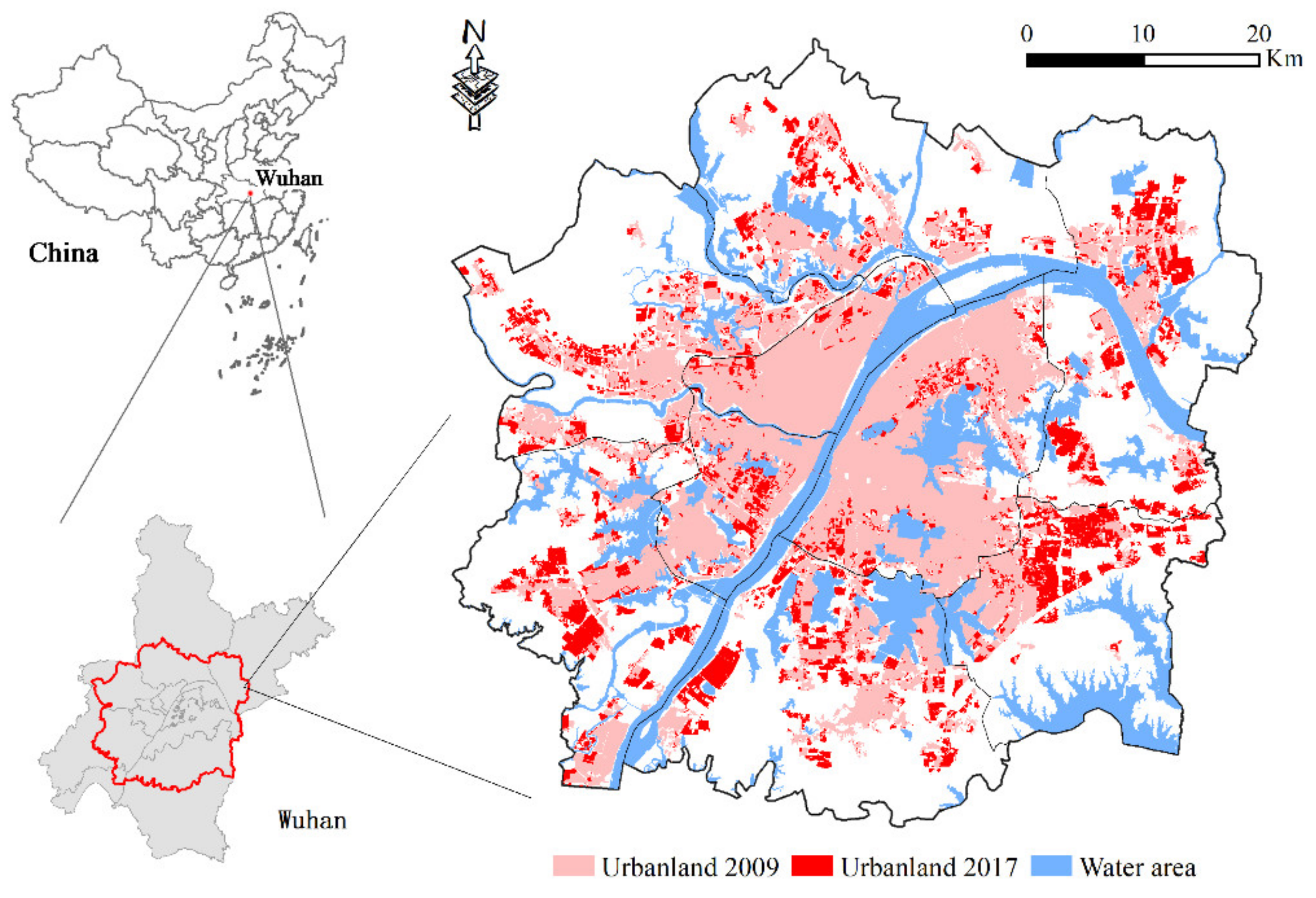
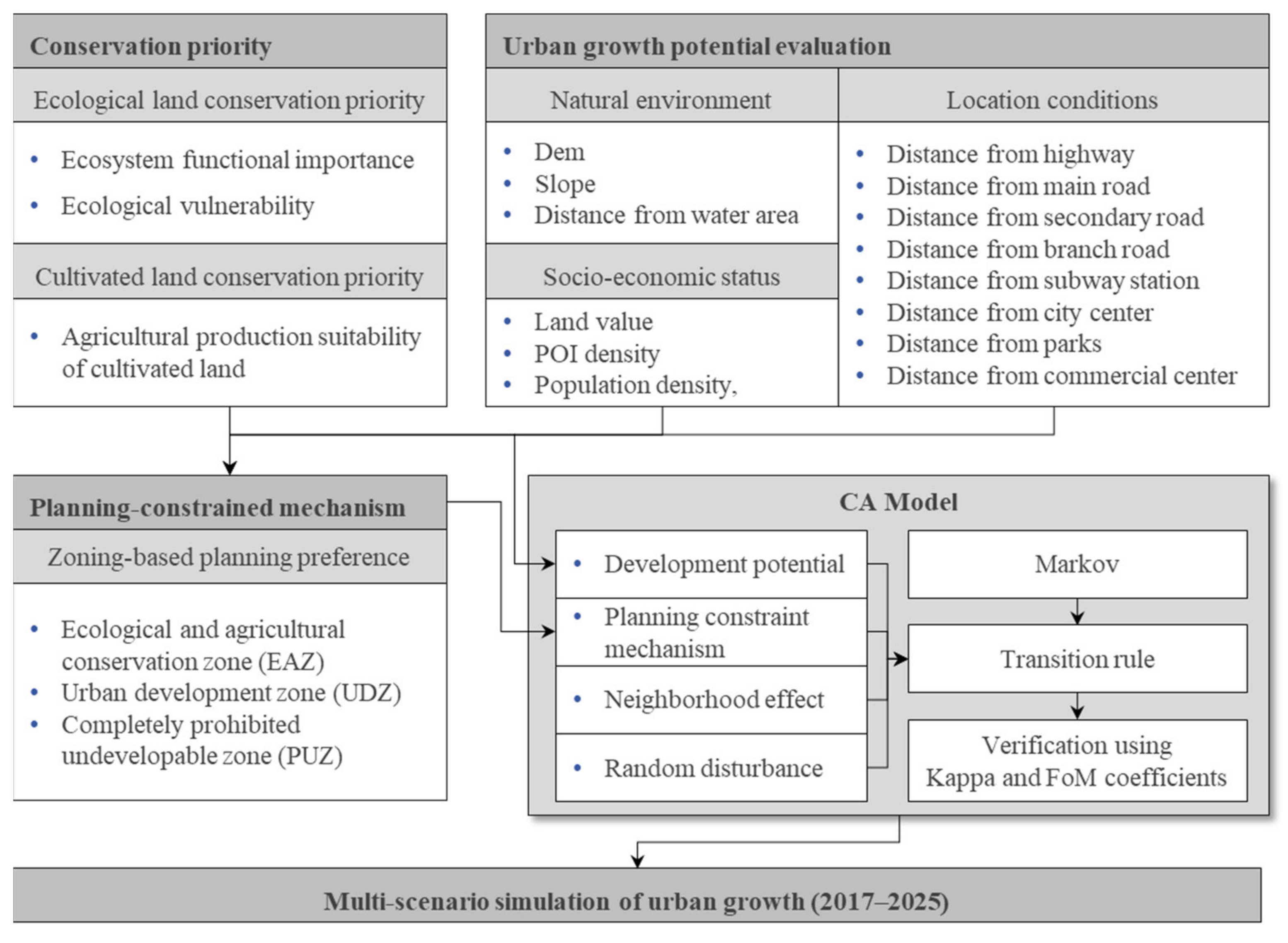
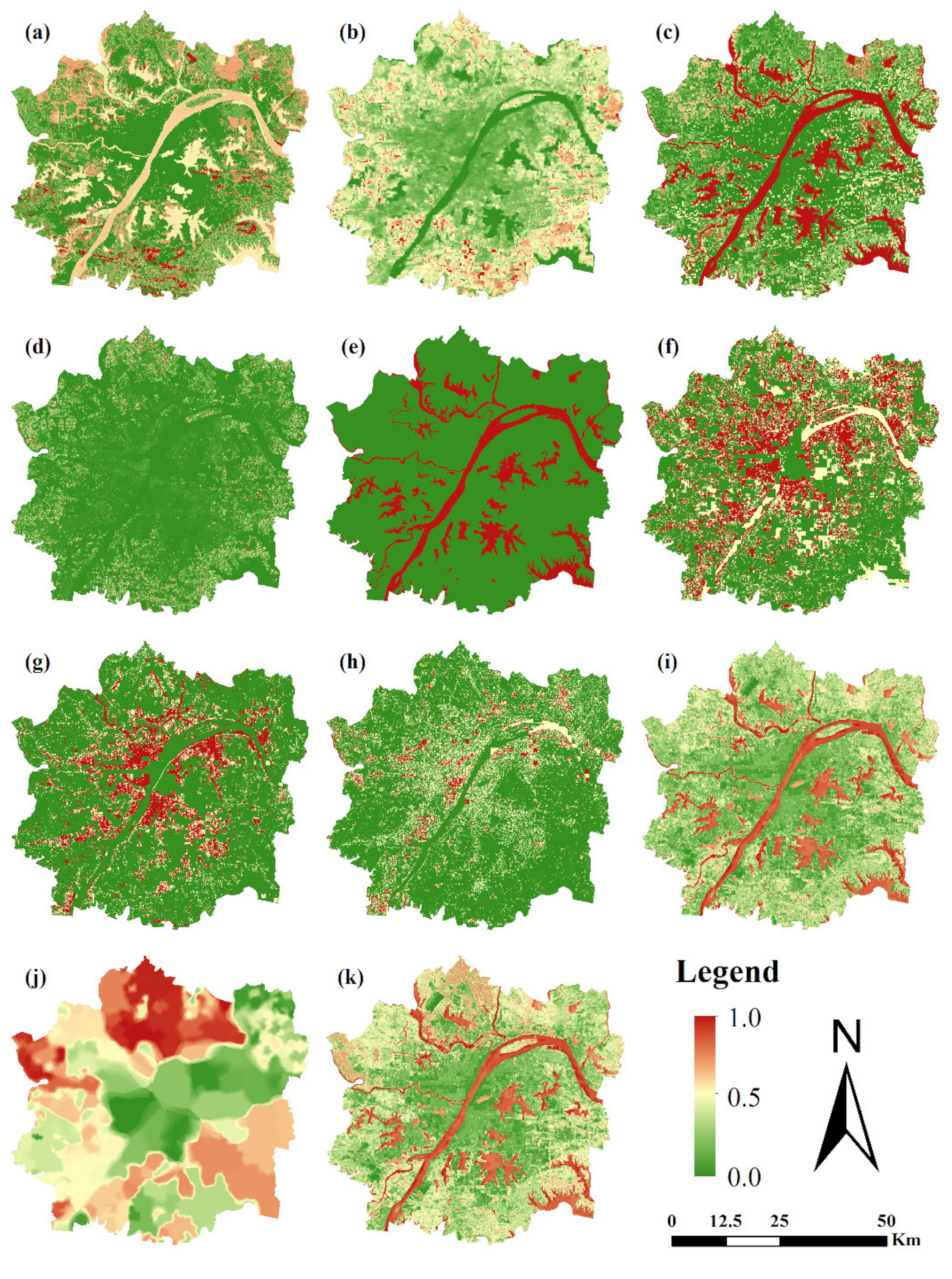
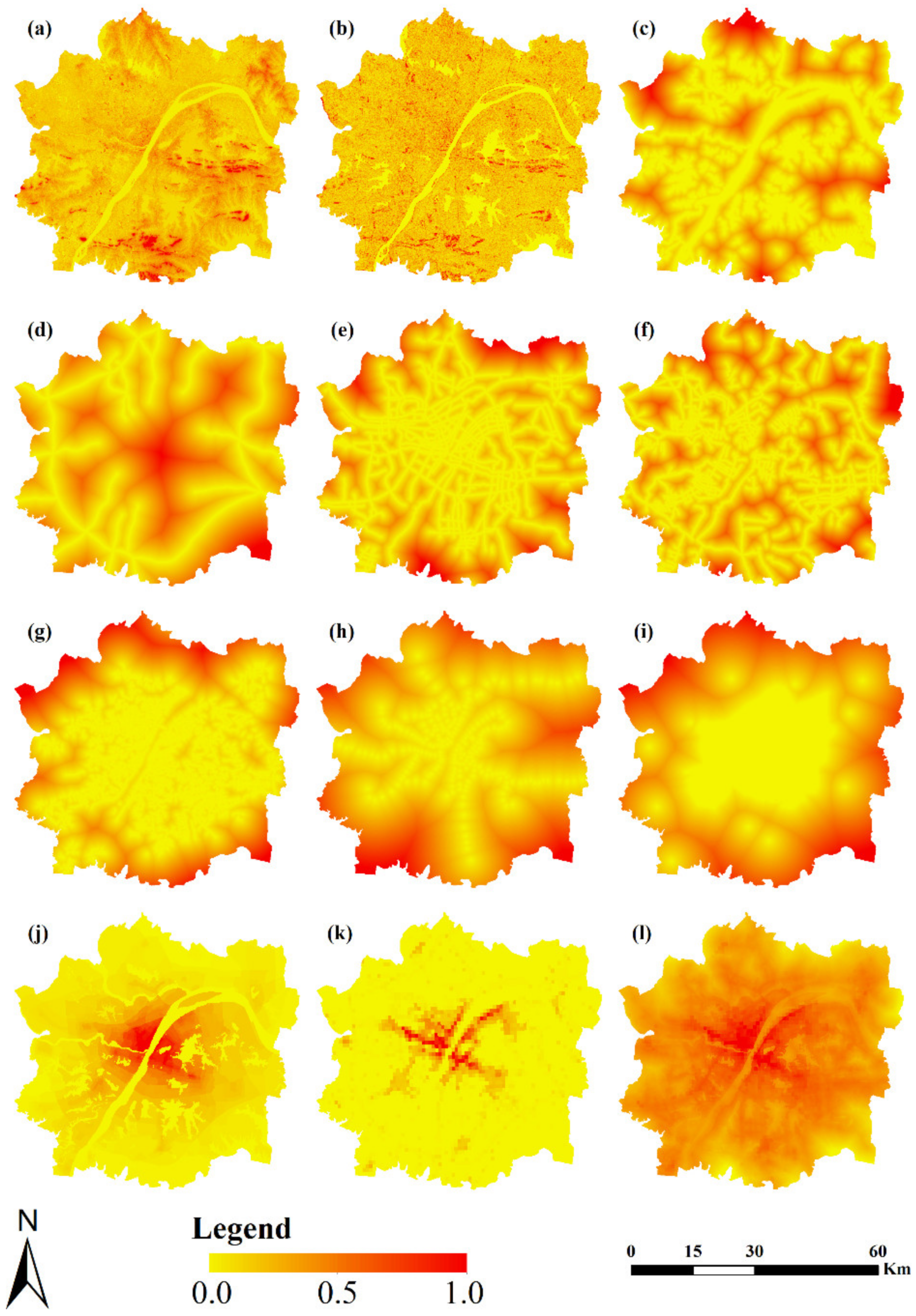
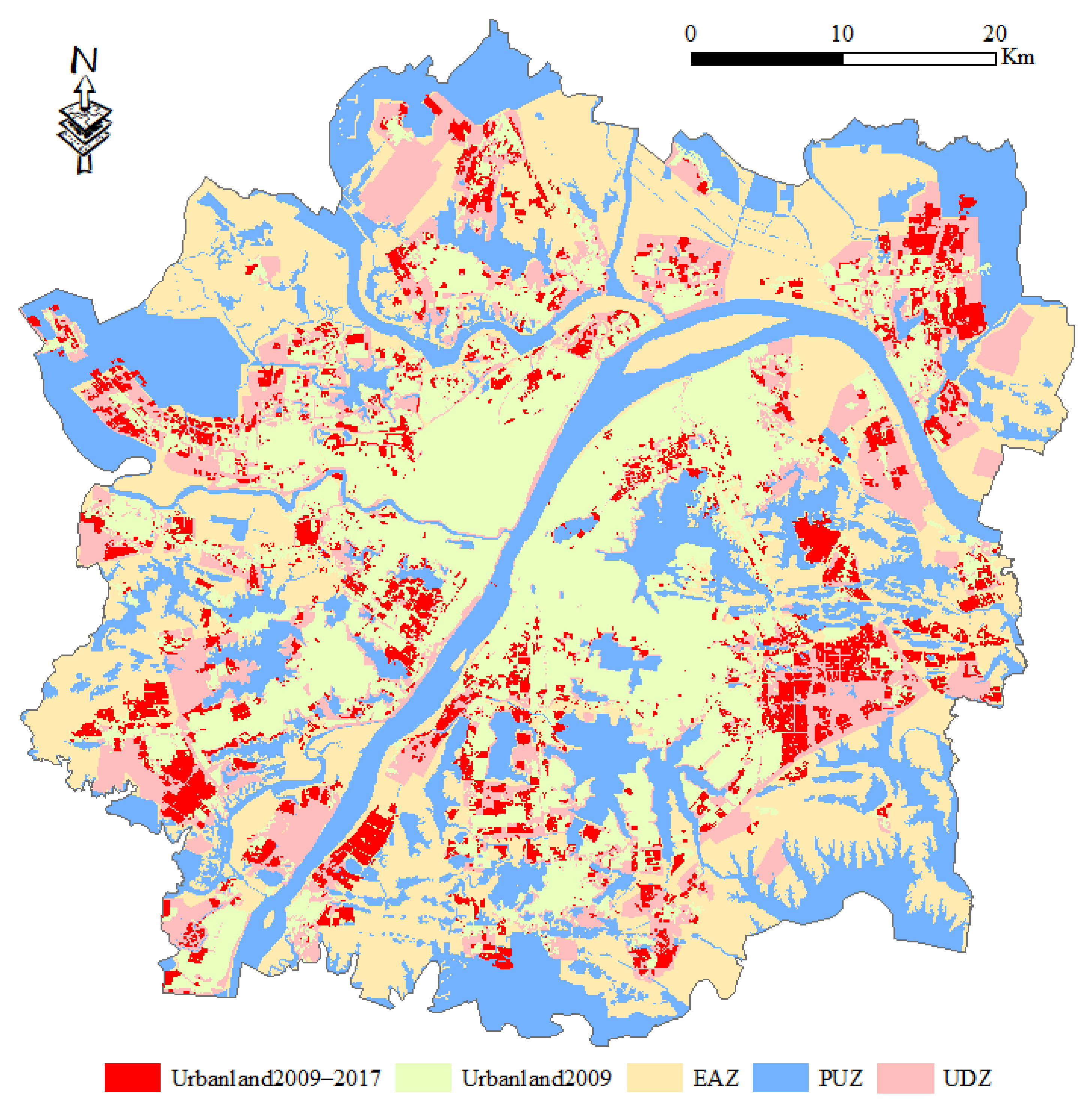
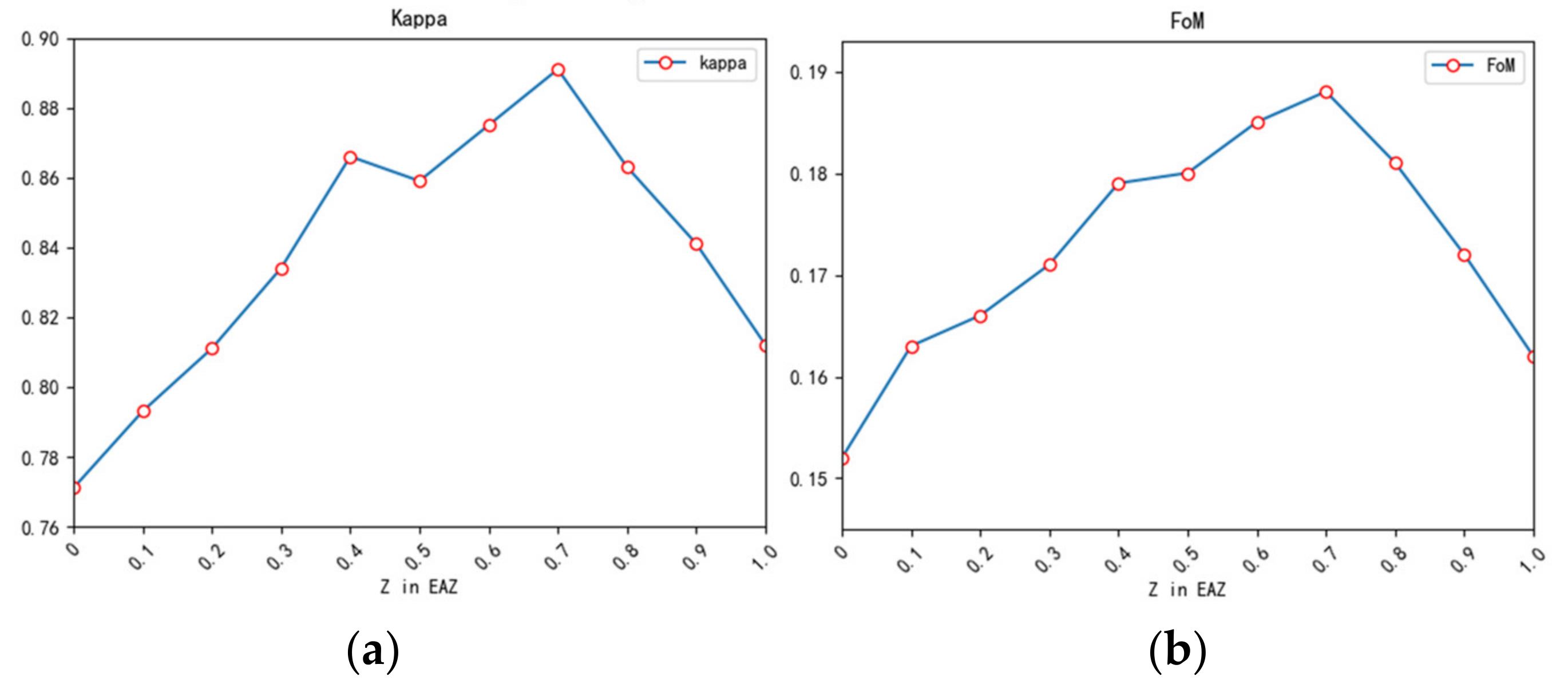
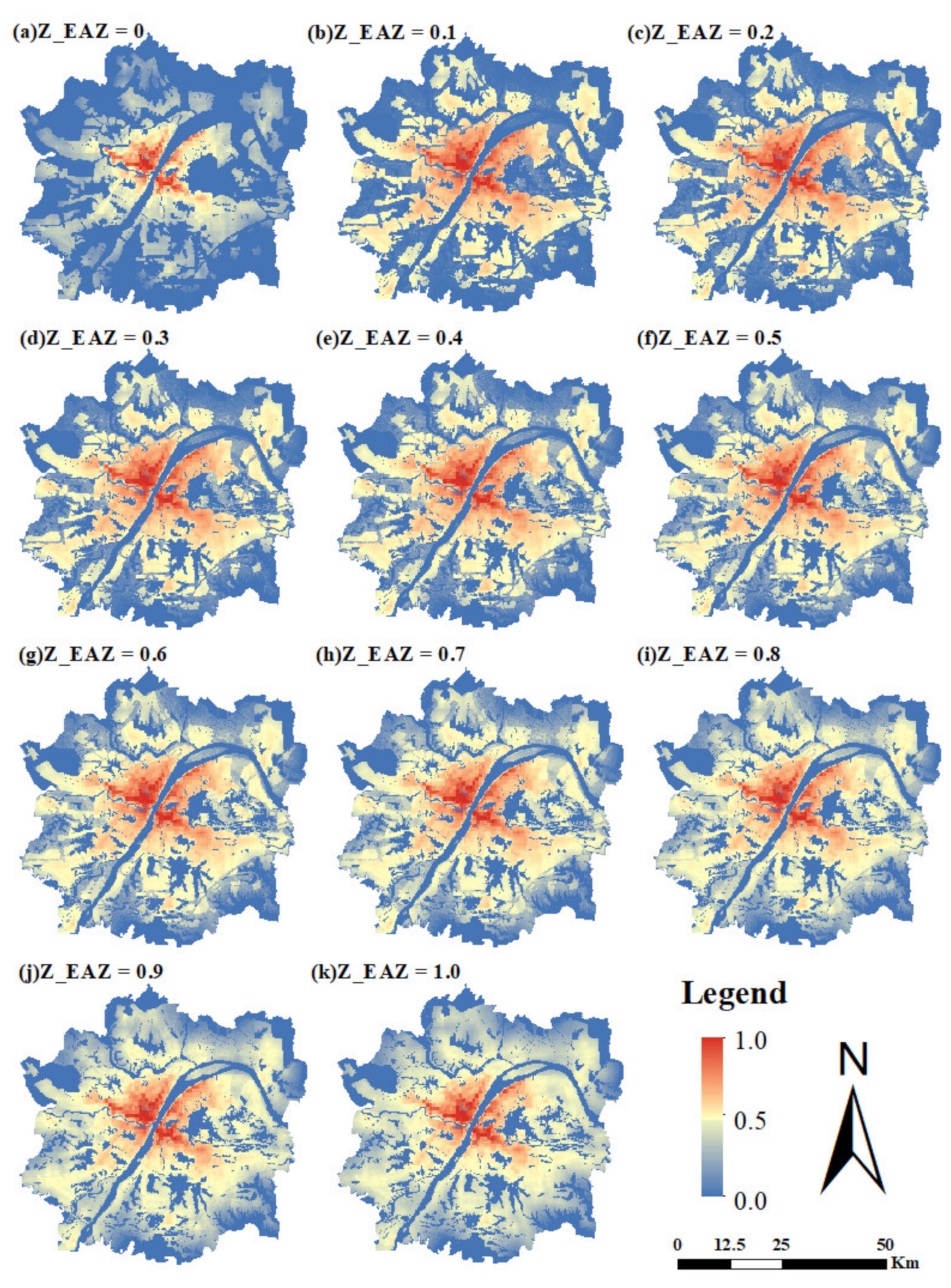

| Indicators | Models | Parameter Explanation |
|---|---|---|
| Biodiversity conservation (BC) | The habitat quality model of InVEST: | is the habitat quality index of patch group x in (dimensionless). and are the habitat suitability score and the total stress level of grid x in , respectively. k is the scale factor (constant). |
| Carbon storage (CS) | Carnegie–Ames–Stanford approach model (CASA):;; | is the ecosystem net primary productivity of pixel x in tst month (gC·m-2·month-1), and are its corresponding absorbed photosynthetic effective radiation and actual light energy utilization, respectively. , ,and are the total solar radiation, the absorption ratio of vegetation layer to incident photosynthetic effective radiation, the influence coefficient of water stress of pixel x in tst month, respectively. T1 and T2 indicate the stress effect of low and high temperature on light energy utilization, is the maximum light energy utilization under ideal conditions. |
| Water conservation (WR) | Water balance equation: | is the water conservation capacity of type i (m3), and n is the number of ecosystem types. , , and are the rainfall, surface runoff, evapotranspiration and ecosystem area of type i, respectively. |
| Soil conservation (SC) | Revised universal soil loss equation (RUSLE): ; | SC is the quantity of soil conservation (t/hm2·a), and are the quantity of potential and actual soil erosion, respectively. R, K, LS, C and P are the rainfall erosivity, soil erosion factor, slope factor, vegetation cover factor and the soil conservation practices factor, respectively. |
| Flood regulation (FR) | The assessment is based on the water level and area of the water body. | The main rivers of the Yangtze River and Han River, large lakes (>1 km2), large- and medium-sized reservoirs are extremely important flood control ecological function areas; others belong to important areas. |
| Soil erosion sensitivity (SES) | SES is the sensitivity index of soil erosion (dimensionless). R, K, LS and C are the sensitivity grades of rainfall erosivity, soil erosion, slope factor and vegetation cover, respectively. | |
| Land desertification sensitivity (LDS) | LDS is the sensitivity index of land desertification (dimensionless). I, W, K and C are the sensitivity grades of dryness index, sand-driving wind days, soil texture and vegetation cover, respectively. | |
| Stony desertification sensitivity (SDS). | SDS is the sensitivity index of stony desertification (dimensionless). D, S and C are the sensitivity grades of exposed area percentage of carbonate stony, terrain slope and vegetation coverage, respectively. |
| Independent Variables | Coefficients | Sig. |
|---|---|---|
| Constant | 1.788 | 0.000 |
| Dem | −2.507 | 0.000 |
| Slope | −0.801 | 0.000 |
| Distance from water area | 1.763 | 0.000 |
| Distance from highway | −1.557 | 0.000 |
| Distance from main road | −6.135 | 0.000 |
| Distance from secondary road | −2.627 | 0.000 |
| Distance from branch road | −1.481 | 0.000 |
| Distance from subway station | −0.299 | 0.000 |
| Distance from city center | −2.424 | 0.000 |
| Land value | 6.358 | 0.000 |
| Population density | 8.528 | 0.000 |
| EAZ | UDZ | PUZ | Total | |||||
|---|---|---|---|---|---|---|---|---|
| Area (km2) | Percent (%) | Area (km2) | Percent (%) | Area (km2) | Percent (%) | Area (km2) | Percent (%) | |
| Cultivated land | 33.41 | 12.68 | 116.46 | 44.20 | 2.87 | 1.09 | 152.73 | 57.96 |
| Garden land | 1.17 | 0.44 | 3.95 | 1.50 | 0.05 | 0.02 | 5.17 | 1.96 |
| Forest land | 2.74 | 1.04 | 7.69 | 2.92 | 0.77 | 0.29 | 11.20 | 4.25 |
| Grassland | 0.59 | 0.22 | 4.54 | 1.72 | 0.04 | 0.01 | 5.17 | 1.96 |
| Water areas | 14.31 | 5.43 | 44.56 | 16.91 | 3.56 | 1.35 | 62.43 | 23.69 |
| Rural settlement | 9.41 | 3.57 | 14.03 | 5.33 | 1.14 | 0.43 | 24.58 | 9.33 |
| Unused land | 0.39 | 0.15 | 1.81 | 0.69 | 0.03 | 0.01 | 2.22 | 0.84 |
| Total | 62.02 | 23.53 | 193.05 | 73.26 | 8.45 | 3.21 | 263.51 | 100.00 |
| ZEAZ | NP | MPS | PARA_MN | ENN_MN | AI |
|---|---|---|---|---|---|
| 0 | 130 | 1031.6834 | 310.3234 | 202.342 | 98.3563 |
| 0.1 | 124 | 1081.3902 | 309.9919 | 203.5717 | 98.3664 |
| 0.2 | 112 | 1197.3471 | 281.6773 | 242.9079 | 98.3771 |
| 0.3 | 101 | 1326.1127 | 260.7926 | 267.2124 | 98.377 |
| 0.4 | 99 | 1354.608 | 266.4246 | 270.452 | 98.3699 |
| 0.5 | 94 | 1425.4162 | 241.3943 | 274.8021 | 98.3691 |
| 0.6 | 94 | 1424.8101 | 258.2396 | 265.5334 | 98.3561 |
| 0.7 | 96 | 1391.0121 | 269.231 | 275.8715 | 98.358 |
| 0.8 | 99 | 1354.4294 | 258.9014 | 276.8843 | 98.3501 |
| 0.9 | 104 | 1287.8022 | 286.3029 | 234.4195 | 98.3556 |
| 1 | 107 | 1251.6569 | 307.4349 | 224.5641 | 98.3379 |
| ZEAZ = 0 | ZEAZ = 0.2 | ZEAZ = 0.5 | ZEAZ = 0.8 | ZEAZ = 1.0 | ||||||
|---|---|---|---|---|---|---|---|---|---|---|
| Area (km2) | Percent (%) | Area (km2) | Percent (%) | Area (km2) | Percent (%) | Area (km2) | Percent (%) | Area (km2) | Percent (%) | |
| Wuchang | 16.68 | 100.00 | 22.66 | 68.32 | 22.28 | 66.01 | 22.24 | 65.37 | 21.71 | 66.09 |
| Hankou | 2.80 | 100.00 | 3.53 | 76.28 | 3.76 | 71.14 | 3.79 | 69.20 | 3.79 | 70.06 |
| Hanyang | 8.48 | 100.00 | 9.07 | 89.06 | 8.73 | 88.91 | 8.69 | 87.98 | 8.47 | 88.19 |
| North | 40.69 | 100.00 | 35.71 | 91.79 | 36.78 | 79.56 | 36.88 | 74.82 | 38.39 | 71.78 |
| East | 45.32 | 100.00 | 44.26 | 79.18 | 43.06 | 70.30 | 42.24 | 67.63 | 41.10 | 67.14 |
| Southeast | 26.40 | 100.00 | 25.84 | 84.05 | 25.22 | 74.37 | 25.64 | 71.86 | 25.07 | 70.68 |
| South | 36.93 | 100.00 | 38.35 | 77.96 | 40.91 | 64.18 | 41.51 | 60.08 | 42.77 | 58.85 |
| Southwest | 38.20 | 100.00 | 37.01 | 78.34 | 36.39 | 66.88 | 37.49 | 61.94 | 37.22 | 61.09 |
| West | 44.80 | 100.00 | 43.88 | 85.16 | 43.18 | 79.18 | 41.82 | 78.21 | 41.79 | 77.51 |
| Total | 260.31 | 100.00 | 260.31 | 81.46 | 260.31 | 72.30 | 260.31 | 69.25 | 260.31 | 68.24 |
Publisher’s Note: MDPI stays neutral with regard to jurisdictional claims in published maps and institutional affiliations. |
© 2021 by the authors. Licensee MDPI, Basel, Switzerland. This article is an open access article distributed under the terms and conditions of the Creative Commons Attribution (CC BY) license (https://creativecommons.org/licenses/by/4.0/).
Share and Cite
Wang, H.; Liu, Y.; Zhang, G.; Wang, Y.; Zhao, J. Multi-Scenario Simulation of Urban Growth under Integrated Urban Spatial Planning: A Case Study of Wuhan, China. Sustainability 2021, 13, 11279. https://doi.org/10.3390/su132011279
Wang H, Liu Y, Zhang G, Wang Y, Zhao J. Multi-Scenario Simulation of Urban Growth under Integrated Urban Spatial Planning: A Case Study of Wuhan, China. Sustainability. 2021; 13(20):11279. https://doi.org/10.3390/su132011279
Chicago/Turabian StyleWang, Haofeng, Yaolin Liu, Guangxia Zhang, Yiheng Wang, and Jun Zhao. 2021. "Multi-Scenario Simulation of Urban Growth under Integrated Urban Spatial Planning: A Case Study of Wuhan, China" Sustainability 13, no. 20: 11279. https://doi.org/10.3390/su132011279
APA StyleWang, H., Liu, Y., Zhang, G., Wang, Y., & Zhao, J. (2021). Multi-Scenario Simulation of Urban Growth under Integrated Urban Spatial Planning: A Case Study of Wuhan, China. Sustainability, 13(20), 11279. https://doi.org/10.3390/su132011279






